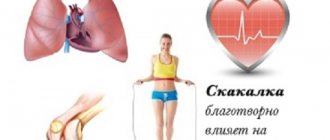Most of us, or rather about 99%, expect one result from fitness - weight loss by reducing the fat layer on the stomach, waist, hips, legs and other “problem” areas. Trainers unanimously claim that sport helps burn fat, but no one specifies what kind of sport it is and what it is eaten with.
You start reading smart literature and find phrases like:
- fat begins to “burn” only after 20-30 minutes of continuous exercise, - aerobics is best suited for weight loss, - strength training only strengthens muscles, but does not affect fat, - the most effective fat-burning workout is training on an empty stomach, - heart rate contractions should be in the range from 60 to 70% of the maximum - you can’t eat for 2 hours before a fat-burning workout, and after it for two hours, you can’t drink either, so that the body uses water from fat, so you’ll lose weight faster...
This list can be continued endlessly, but what's the point? I propose to figure out together what types of fitness best promote fat burning and how to do them correctly so as not to waste your time and energy.
cardio vs strength training. And against interval training. What you need to know.
Here are today's three competitors:
- Cardio : Almost anything you can do for a long time and at a relatively low intensity. However, such exercises increase your heart rate. This includes aerobics, running five kilometers, Zumba, working out on a treadmill for an hour, on an elliptical trainer for 20 minutes, and so on.
- Interval training : This is where you will run, bike, elliptical, and similar activities at varying speeds and intensities. Sprint for 30 seconds followed by a 90-second jog and repeat this cycle for 20-30 minutes.
- Strength training : Any time you lift weights or do bodyweight exercises, often of a cyclical nature.
Hundreds of studies have been conducted on the comparison of these three types of training. I will also use their results today. In order to draw a thick line under all disputes by the end of the article.
But I want to say only one thing - all of the three types of training can be useful at certain times.
Why is it so important to find out which workouts are effective for burning fat?
Also because you can spend colossal sums on activities that later turn out to be ineffective. So it’s better to immediately choose the best workouts for weight loss.
Another important point. If you are passionate about getting in shape, you need to adjust your diet in advance of your workout.
Trust me when I say that your diet is responsible for 80-90% of your success or failure.
Anyway!
As I said earlier, even if you spend more than 10 hours a week on exercise, that still leaves you with 168 hours. And that's enough to ruin everything because of your food.
If all you care about is losing weight, then the fastest route to success is a really cool diet.
Keep your total calories under control, cut out junk food, ditch the soda, and start eating real food: vegetables, fruits, and lean meats.
Don't make the same weight loss mistakes that many people make.
Ab crunches
This complex is an excellent remedy for belly fat. It not only helps you lose weight, but also trains your abs, thereby strengthening the abdominal wall. For the effect to be noticeable, you need to eat rationally (do not go on strict diets) and give the body enough time to rest.
The list of exercises includes:
- Regular crunches. You need to lie on your back, bend your knees, and put your hands behind your head. As you exhale, lift your upper body, while “twisting,” and as you exhale, lower yourself down. Repeat the exercise 10-20 times;
- Reverse crunches. Lie on your back, bend your legs and place your arms along your body. Raise your legs and pull your knees towards your chest as you exhale. Place your feet on the floor and inhale. Repeat the exercise 10-20 times;
- Oblique twists. Lie on the floor in the same position as for regular crunches. The feet should not touch the floor. When twisting your upper body, turn it to one side and then lower yourself to the floor. Alternate turns in different directions. Do about 10-15 repetitions on each side;
- Crunches with leg raises. Lie on the mat, stretch your legs up, crossing them. Do regular crunches. Exhale as you rise and exhale as you lower your body. Do 20-25 repetitions;
- Side crunches. The exercise is similar to oblique crunches, but differs in that when lifting the body, you need to lift one leg. For each side, do 10-15 repetitions;
- Bicycle crunches. Lie face up, hands behind your head. Raise your legs and bend them at the knees, pull one knee to your chest. When raising your knee, you need to try to reach the opposite elbow. Do 10-15 repetitions on each side.
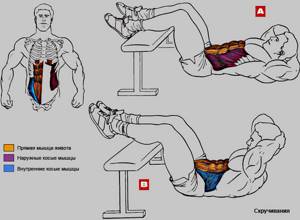
Different types of crunches are great for training your abs. Exercise strengthens several muscle groups, which promotes good digestion, straight posture and improved physical health.
Is cardio training effective for burning fat?

Cardio is one of the main ways for those who want to lose weight.
The science on this topic is stated briefly. If you lose more calories per day than you consume, your weight will inevitably decrease.
This process is called calorie deficit.
Get on the treadmill or put on your running shoes and run five kilometers and you'll burn about 300 calories.
In this case, you do not need any equipment or knowledge of “sophisticated” exercises. Just run and run.
Because this activity has one of the lowest barriers to entry, many people get started by simply running on a treadmill or doing an elliptical in the park for a few hours. In this case, it is difficult to spoil something, and there is nothing complicated.
There are a few challenges with cardio: While running outside or going for a long walk can be exhilarating, spending time on a treadmill or elliptical trap at the gym or at home can seem boring and monotonous to some.
However, if you enjoy cardio, keep doing it.
Secondly, cardio definitely helps improve your heart health. It trains your heart like a muscle to stay in shape. And stay at a fairly high level of performance during training.
However, since you are doing a consistent form of exercise, you are not actually training the body enough.
But he must be able to experience moments of extreme stress. This is because such exercises never challenge the body with rapid physical changes (explained in the next section).
Finally, in terms of getting in shape, it's definitely not the most effective form of exercise.
Why? There is literally a minuscule EROS indicator. It is also called excess post-workout oxygen consumption. This means that you only burn calories while running. And a very small amount of calories at the end of the workout.
What's good about cardio training?
The point is that cardio is what makes it well suited for many. Cardio doesn't require any special training. You can also perform cardio workouts to burn fat in a fairly large volume.
Whether you're walking or going for a slow jog or hike, you can do cardio every day for a few hours, burning calories and benefiting your health.
Training running also applies to such activities.
I will also note that such training makes many exercises fun and exciting. Whether it's dancing, walking or running on the treadmill. If you like cardio training, then nothing prevents you from devoting a lot of time to it!
Full body program
For experienced athletes with great endurance, it is not difficult to follow the practice of alternating basic exercises (squat, bench press, deadlift), combined into a superset for the whole body.
Fat burning workouts are designed to do the work that creates a carbohydrate deficiency in the body. As a result, the breakdown of fat cells occurs.
Beginners are advised to create a set of exercises for all parts of the body for four weeks, four days for each.
First week - combined exercises by day:
- Alternate supersets on legs and shoulders with supersets on arms (with emphasis on triceps).
- Leg workout (working the buttocks) + abs.
- Work on the torso (chest and abdominal muscles).
- Back + arms (with emphasis on biceps).
Second week - work with antagonists:
- Chest and back.
- Hips, quads and calves.
- Supersets for arms that work the shoulders and triceps.
- Working out the torso with emphasis on the deltoid muscles and back.
Third week - supersets of three exercises that burn calories to the maximum:
- Sets for chest and triceps.
- Quadriceps, hamstrings, abs and calves.
- Superset on all three bundles of shoulder muscles and triceps, then in a separate session working on the trapezius.
- Biceps, then back and quadriceps.
Fourth week - from the above examples, a program is drawn up (under the guidance of a trainer) to increase lean mass for the fourth week. A distinctive feature is that up to six exercises of five repetitions are done per approach. But the latter is performed until the muscles completely fail, so safety net is necessary. Rest is reduced to 15 seconds.
This is how a set of weight loss exercises works for all muscle groups. At the end, you need to rest and start again.

What about high intensity interval training for weight loss?
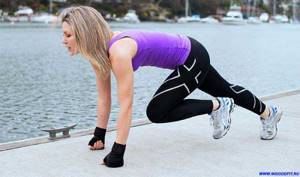
The essence of these activities is to change the speed and intensity when cycling, running and similar activities. For example, start by jogging for 30 seconds. Then sprint for 30 seconds.
After this, jog again for 30 seconds and sharply accelerate for 30 seconds.
When it comes to calorie-burning efficiency, high-intensity training is far ahead of cardio.
Why is this so?
EROS!
We have already talked about it before. Essentially, when you do high-intensity interval training (HIIT or HIIT), your metabolism works at an increased rate of “destroying” calories for many hours afterwards.
In this case, you don’t even need to think about how to improve your metabolism.
What does this mean?
This means that you “destroy” calories by sitting in front of the computer, playing various games or watching your favorite TV series.
So how the hell does this work?
HIIT constantly forces your heart to adapt to changing conditions: sprints, jogging, sprints, jogging, up hills, down hills, etc. Your heart learns to work outside of its norm, and your body learns to adapt to these changes.
All of these changes and sprinting kick your metabolism into high gear for hours after you finish exercising.
What else?
A study by researchers at the University of New South Wales tracked changes in fitness and body composition in 45 overweight women over a 15-week period.
The women were divided into two groups. They were prescribed interval or continuous cyclic treatments.
The high-intensity interval group performed twenty minutes of exercise. They consisted of repetitions of eight seconds of exercise at extreme intensity, followed by twelve seconds of light exercise at a leisurely pace.
The next group trained for 40 minutes at a constant intensity. At the end of the study, women in the interval group lost three times more fat than women in the continuous exercise group.
But it sounds good, doesn’t it?
What's wrong with interval training?
When you do interval training at higher intensity, the recovery period may be too short. And your body will not have time to rest. That is, such training is quite grueling.
You may also feel sore the next day compared to if you did the same amount of cardio over the same amount of time.
And finally, you are reading this article to learn about the most effective weight loss. But if you then replace cardio with HIIT, then after a while you can forget about the effectiveness and return to cardio training to burn fat.
In this case, everything depends on you.
But remember that the best training program and nutrition system is the one that you strictly adhere to.
Biceps workout
A superset for pumping up antagonists consists of multi-joint and isolating practices. The same applies to the shoulders and back. Since the muscles are located parallel to each other, the biceps is responsible for flexing the arm at the elbow, and the triceps is responsible for extending the arm.
The most common example of a superset for biceps:
- biceps curl;
- close grip bench press.
It is important to choose a light weight so that it is enough for 12 – 20 repetitions. Ideally, it is better to do the bench press with a safety net, since towards the end of the training the arms will begin to fail and there is a risk of dropping the apparatus on the chest.

And now about strength training for burning fat and its benefits.
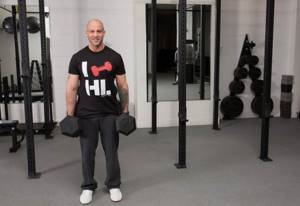
So, if cardio workout is good for burning calories during exercise. And high-intensity interval training is more effective because it burns calories both during and after the workout, so what can strength training do for fat loss?
Let's first look at one of the many studies on the benefits of strength training over cardio.
All subjects in this study were overweight and were divided into three groups. Among them are a group with only special nutrition, a nutrition group plus aerobics classes, and a group with the same dietary nutrition plus aerobics and strength training.
The study period lasted twelve weeks.
During this time, participants in the group with only fitness nutrition lost an average of 6.5 kg, while the group “nutrition plus aerobics” lost a little more than -7 kg. Classes were held 3 times a week. Moreover, they started from 30 minutes and increased to 50 minutes evenly over a period of 12 weeks.
And the most important thing. Participants in the third group, “nutrition plus aerobics plus weight training,” lost an average of 9.5 kg of weight (or fat).
Basically, adding aerobic training failed to produce any real fat loss compared to diet alone.
Thirty-six sessions lasting up to 50 minutes is a lot of work for one extra 500 grams of fat loss.
However, introducing resistance training into the program significantly accelerated fat loss results.
The conclusions suggest themselves. What you eat is the most important thing when it comes to weight loss. Aerobic exercise helps, but not as much as you think. Strength training combined with these two is the most effective method of weight loss.
"Why is this so?" -you ask. During strength training, you are actually rapidly destroying the muscles in your body. Such workouts, whether they are with special equipment or simply exercises with body weight, involve all muscle groups. And they force them to burn hundreds of calories.
If in this case there is mass gain, it must be of high quality. The first question for you will be how to build muscle and not fat.
But it's not over yet. Coming home and relaxing while watching another movie or dull negative TV news, your body's metabolism will continue to work at an accelerated pace. The reason for this is the body’s work to restore damaged muscles.
This may continue for more than 36 hours after the end of the workout.
But there is no need to idealize them. Strength training has both positive and negative sides.
Positive side.
If you have a limited amount of time and are looking for the most effective workout, strength training provides one of the best solutions in this case.
Strength training also helps you build the body you're looking for and can help keep you injury-free, healthy, and happy for the rest of your life.
Negative side.
On the other hand, if you exercise without additional training and without special knowledge, you expose yourself to an increased risk of injury. The same is the case for beginners with poor physical shape. After all, when strength training you do a lot of aggressive movements that you will not find if you go for a walk or do a simple run. Eg.
Additionally, if you simply don't like strength training, this may prevent you from being productive in the sport. In this case, the best exercises are the ones you choose for yourself.
So after all,
Strength training for beginners
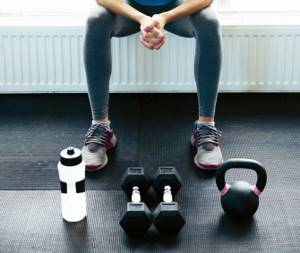
Let me remind you that today we are talking specifically about fat-burning workouts. This means that I will not focus on the exercises (Google them is not a problem), but will talk about the principles of constructing training and give examples for beginners and for more experienced citizens. Having understood the essence, you will select exercises for yourself or get a more experienced comrade (trainer) to do this, briefly describing the basic principles. Just in case, here are a few topical articles where you can get exercises:
- How to effectively establish a training process
- How to gain muscle mass
- Top 10 exercises I do in the gym
- Gym Exercises You Didn't Know About
- Even more correct exercises in the gym
Well, let's get to the point . Strength training is a regular stress on muscle fibers, to which the body gradually develops an adaptation (increase in strength and muscles). As for fat burning (energy expenditure), firstly , during training a large amount of mechanical energy-consuming work is performed. Secondly , energy will be spent on restoring spent resources (resynthesis) and creating new ones (protein synthesis, that is, new muscle fibers). Double profit.
Based on what has been written above, one simple but important principle becomes clear - constant progress . Smooth, gradual, but progress. This could be increasing the weight of the apparatus (a little at a time, while maintaining the technique of performing the exercise) and increasing the number of repetitions. Easily perform 12-15 repetitions in 3-4 approaches - increase the weight of the projectile.
If you come to exercise as a complete beginner, then in the first month or two you should not even focus on the scales, but on the technique of doing the exercises. Having studied the exercises, learned how to do them correctly and accurately, without “cheating” and bending your body in strange positions, you begin to gradually increase the weight of the equipment.
But in any case, at first, a beginner will not be able to load the muscles so much that they will have to recover for a week . Injuring yourself is easy if you overdo the weights or do the exercises incorrectly. It's unlikely to be fully loaded. There is not enough energy potential, endurance and banal experience.
That is, there is no point in working in a classic split, when each muscle group is trained once a week. In this mode, the beginner ineffectively loads the muscles and actually marks time. At least if we are talking about fat burning. And about progress in general too.
It is much more effective to work out all the main muscle groups at once and so on three times a week , varying the exercises and focusing on working with free weights (barbell, dumbbells, your own body).
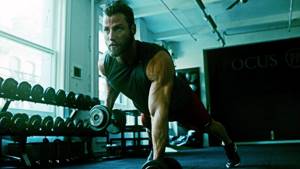
Naturally, try not to overload your workouts with too heavy exercises. Let’s say one day you do squats on your legs - it’s hard. On another day, extensions or lunges will do. You shouldn't use deadlifts along with squats. But on a day with lunges, it’s fine.
The number of approaches four at first , taking into account the gradual increase in weight from approach to approach (the number of repetitions can be reduced within reasonable limits, from 15 to 8 times). Over time, with increasing strength indicators, you can increase the number of approaches to 5–6, taking into account the first two warm-up ones.
Example workout:
- Squats with a barbell on the shoulders (legs).
- Pull-ups (medium grip, slightly wider than shoulder width; if you don’t have enough strength to do pull-ups, then pull the block to the chest ) (work the latissimus dorsi, partially biceps and rear deltoids).
- Bent-over barbell row to the stomach or pull-down block to the stomach , or lever row (works the latissimus dorsi, partially trapezius, rear delta, biceps).
- Bench press with a barbell at an angle of 30–40° or a dumbbell press with the same inclination (the best option for working the chest, since with a classic bench press on a horizontal bench, not everyone works the pectoral muscles properly) (works the chest, partially the anterior delta and triceps).
- Standing dumbbell press or seated Arnold press , or military barbell press (works the shoulders - the front and middle beams)
- Barbell press with a narrow grip (shoulder-width apart or slightly narrower to make it comfortable for the wrists) on a horizontal bench or triceps push-ups (works the triceps, slightly touching the front deltoid and pectoral muscles).
- Lifting dumbbells or barbells for biceps (you can safely skip it, but guys love to pump their biceps, so if you didn’t load the “biceps” well on pull-ups and back rows, we’ll include it in the work).
- Crunches (works the abdominal muscles).
The training is quite extensive, but you should understand that a beginner will not load himself so much that his legs will give way. So the amount of work is acceptable. Rest between approaches depending on how you feel - your breathing is restored, proceed to the next approach.
Girls can forget about separate exercises for biceps and triceps , replacing them with something for the buttocks and legs: Romanian deadlifts, hyperextensions, sumo squats with a kettlebell or dumbbells, etc.
You can safely work in this mode for two to four months. Until you feel like your body doesn’t have time to recover and you need to break your workouts into muscle groups to give individual muscles more rest.
What workouts are effective for burning fat?
If you are not satisfied with anything in the previous lines, then you can, of course, find another site about fitness and health. It may contain other information. The one you like. And even with many studies and their results.
But let's still face the truth.
While I'm a big proponent of strength training, especially bodyweight training, that doesn't mean I'm against other weight loss methods.
Let's just look at the numbers.
For the same duration of training, say 30 minutes), strength training will burn more calories than high-intensity interval exercises. And those, in turn, will be more effective in this regard than cardio.
However, due to the stressful nature of strength training and HIIT, you can only really do these activities for 30-45 minutes. After this, your body will need several days to recover.
Stationary cardio workouts such as walking or elliptical training do not put as much strain on the body. Their low load allows them to be practiced for a long time. This means that depending on your fitness level, you can do cardio for hours at a time. And then repeat the classes the next day.
Yes. This can burn more fat than strength training. But here's the kicker. Let's say you trained strength for 30 minutes and then did a few hours of cardio. In this case, you get the benefits of two types of training.
In any case, it all depends on your preferences, availability of free time, your goals and something else.
Yes Yes. Remember that 90% of this battle is in your diet.
So no matter how you exercise, if you want to lose weight, your best chance of success is to have a nutrition strategy to follow!
A guide to fitness nutrition for beginners will help you with this.
Exercises for fat burning
To burn fat, trainers recommend combining aerobic and anaerobic exercises. Cardio helps burn fat, and strength training trains muscles and gives you a sculpted figure.
There are two options for combining such loads:
- One day is devoted to cardio training, the other day to strength training;
- The training combines two types of exercises. For example, a class starts with cardio and ends with strength training. Each exercise trains a specific muscle group.
For training to be effective, it is necessary to combine different loads. You can also exercise with small weights.
For weight loss, low weight dumbbells with a high number of repetitions are effective.
Plank and slopes
The plank is an excellent exercise for burning subcutaneous belly fat. It does not pump up the abdominal muscles, making them more pronounced and voluminous, but only burns fat deposits. The complex consists of different types of planks, as well as bends and various lunges:
- Plank with a turn. Lie on your side, leaning on your arm bent at a right angle. Stretch your legs and keep them straight. Raise your hips and stay in this position for half a minute. Trained people can stay in this position for 1-2 minutes. Do the same exercise on the other side of the body;
- Lunges with twists. Lunge forward with one leg and extend your arms parallel to the floor. When you step forward, imagine that you are sitting on a chair. Rotate your body and then rise. Repeat the same exercise on the other leg, 15 times for each side;
- Tilts to the side . Stand up straight, put your hands behind your head. Bend to one side as much as possible and stay in this position for a quarter of a minute. Straighten up and repeat the same for the other side. Subsequently, the time can be increased;
- Vacuum. This exercise helps to flatten your stomach and improve digestion. It is better to do it in the morning before breakfast. You need to get on all fours, relax your abs and breathe deeply. Tighten and pull in your stomach for 0.5 minutes. Repeat 5-10 times;
- Raising your legs on a chair. Eating on a chair, lower your arms along your body. As you exhale, pull your knees towards your chest, holding this position for 10 seconds. Inhale and lower your legs. Do 10-15 repetitions.
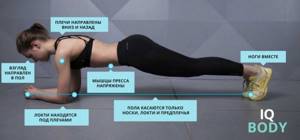
It is better to perform these exercises on an empty stomach or 3 hours after eating.

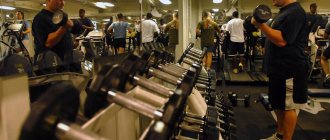

![Cardio training for burning fat at home [video selection]](https://activel.ru/wp-content/uploads/kardio-trening-dlya-szhiganiya-zhira-doma-video-podborka-330x140.jpg)




